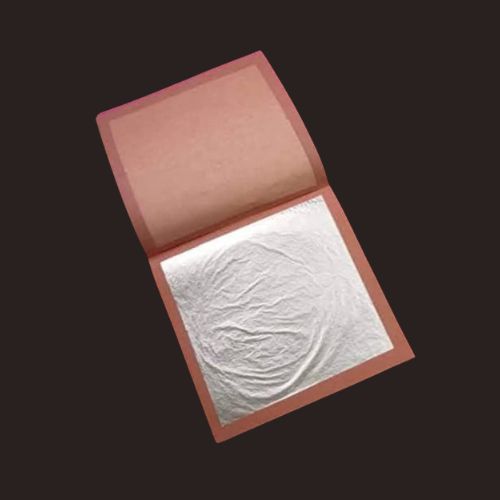 In pastry arts, there’s hardly a component that can glisten on the plate, or add such refinement to the dish, as much as edible silver leaves. Also known by its Indian name of Chandi Vark, these thin silver sheets are not only fully food-safe, but have become the latest culinary & baking must-have accessory for those seeking something a little special.
In pastry arts, there’s hardly a component that can glisten on the plate, or add such refinement to the dish, as much as edible silver leaves. Also known by its Indian name of Chandi Vark, these thin silver sheets are not only fully food-safe, but have become the latest culinary & baking must-have accessory for those seeking something a little special.
Burgundy blooms and silver leaves:
Leaves are thin silky sheets of silver, which is available in ‘pasika silver’,a type of silver that measures as thin as 0.0001mm thick. Because they are fragile they are called ‘leaves’. In the past silver has been used in manufacture of the food utensils and vessels since it is safe when used with food products. Today, however, it remains in demand only as an ornament that can turn an ordinary dish into a gourmet menu. Introducing these leaves into our foods is a common sight in restaurants, baking schools,and special occasions, thus the high value attached to these products.
Key Features and Benefits
The one feature that those interested in consuming the edible silver leaves can hardly fail to notice is its flexibility. In as much as they are best known for use in Indian sweets such as Kaju Katli, they are more versatile than that. These shining sheets may be employed for decoration of cakes, pastries, chocolates and other various confectionery and baked products. They shine and reflect the healthiness and quality of the food and this also makes the meals to maintain the shiny looks from when it left the kitchen to the table. Most advantageous of all, applying silver leaves is easy, so anyone who wants to make his entrees more noble will find the means.
Applications in Culinary Arts
The culinary applications of silver leaves are both diverse and exciting:It might be now extrapolated that the culinary uses of silver leaves are as vast and interesting as they can get:
Cake Decoration: Specifically, the cake decorations including the silver will make the birthday, wedding or any other occasion to be luxurious and sophisticated.
Pastries and Chocolates: Mix of silver and dark chocolate worths seeing: ordinary products transform into exquisite food.
Gourmet Dishes: Silver leaves are put on dishes on the top in the luxurious restaurants to symbolize such luxury and amount of extra effort.
Special Occasions: All celebrations like anniversaries, weddings, birthdays and others to name but a few, could be even more and more special with the aid of the silver leaves extra shine.
Proper Usage and Storage
Silver leaves have one more quite strange property: to use them, they do not have to be washed, so that the leaves will remain pure. But at the same time it is necessary to bear in mind that they have to be operated carefully not to jeopardise the quality as well as the level of hygiene of the consumable products. Linked to the utilization of silver leaves it is recommended that it be used after the cookery or baking procedure is complete because the contact between the silver leaves and other food ingredients is prohibited.
The proper storage procedure is also equally significant. Silver leaves should therefore be preserved in a dark area far from light and this will also avoid the influence of humidity. Since they last for very many years, it is advisable to use them as soon as one purchases them.
Safety and Regulations
Since edible silver leaves are used in cooking, growers In addition to suppliers should follow the quality Food Standards. For instance in India products meant for human consumption have to be graded by FSSAI as a measure of ensuring that such products are fit for human consumption
Culinary decoration :
When it comes to edible decorations, such as the edible silver leaves that are slowly finding their way on the food circuit, then the trend will further be witnessed. Chefs and food artists never cease to look for ways to innovate on this opulent factor, whether in molecular cuisine or modern culinary hybrids. They are also driven by consumer’s willingness to pay for Instagrammable food presentations where the placement, appearance and combinations of the food items could sway consumers’ decisions.
Conclusion
From being a tool for ornamentation in cooking, the silver leaves are more than a link between the past and present generations of chefs and confectioners. They lend aesthetic value to a wedding cake or make a gourmet dish or, indeed, add a touch of sophistication to a simple dessert dish. And, as this glistening trend persists in the food business, it could be said that the fascination with edible silver leaves is just as strong

